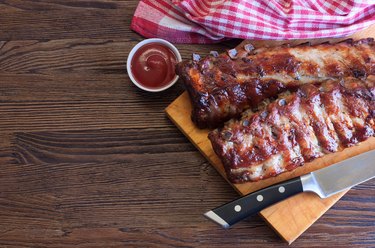
Between work, family responsibility and social activities, homemade meals aren't always an option, especially with items such as ribs that can take an hour or more of prepping and cooking. But with a little finesse, you can prepare precooked ribs in oven and make it feel homemade.
Tip
The best way to cook your precooked ribs is to follow the directions on the package. Ribs come in different types and styles, and the maker should provide the best cooking instructions. Whatever method you use — grill, oven or microwave — be sure to cook until the ribs, beef or pork, reach an internal temperature of 165 degrees Fahrenheit.
Video of the Day
Beef Ribs or Pork Ribs
When it comes to ribs, your options aren't just limited to beef and pork, but also to the various rib cuts for each animal. Deciding between precooked beef and pork ribs, as well as cut, may ultimately come down to taste preference and whether you're able to find your preferred cut of ribs precooked at your grocery store or butcher shop.
Video of the Day
Cuts of beef ribs include back ribs and short ribs. Back ribs are considered an economical rib choice and are often flavored with a dry rub and barbecued. When you're looking for fall-off-the-bone rib meat, short ribs may be the choice for you. These ribs are usually grilled or slow roasted.
Despite its smaller size, pork offers more rib cuts than beef. Pork rib cuts include back ribs, spare ribs and country-style ribs. Back ribs, or what you may know better as baby back ribs, can be barbecued, slow-cooked, roasted or even prepared in your Instant Pot. Spareribs are the least meaty of the pork rib cuts, but have a lot of flavor and make the best rib choice for recipes that call for browning or frying. Country-style pork ribs are the meatiest cut and can be prepared grilled or roasted.
Read more: How to Cook Pork Ribs on a Propane Grill
Cooking Your Precooked Ribs
When it comes to preparing your precooked ribs, you'll get the best results following the directions on the package. Due to the various types and cuts, the best cooking methods and times can vary. However, whether you're reheating precooked baby back ribs or short ribs, the USDA recommends you reheat the meat until it reaches an internal temperature of 165 degrees Fahrenheit.
Precooked beef and pork ribs can be prepared in the oven or grill. Some makers may suggest one method over the other based on the rib cut, original cooking method and seasonings used to add flavor.
One manufacturer suggests their precooked baby back ribs are best reheated in a 375-degree Fahrenheit oven wrapped in foil for 30 to 35 minutes. However, the package also provides grill and microwave instructions for their precooked ribs. On the grill and wrapped in foil, precooked baby back ribs require 15 to 20 minutes of cooking, while in the microwave the ribs only take about 5 minutes.
Reheating your precooked beef ribs may include similar instructions as the precooked baby back ribs. Follow the instructions provided by the maker of your beef ribs to get the best results. The package may include instructions on how to reheat your ribs in the oven or grill and provide recommendations for the method that works the best.
Read more: How to Cook the Most Tender Short Ribs Ever
A Look at Rib Nutrition
Whether they're beef or pork, rib cuts are high in fat and calories. For example, according to the USDA, a 3-ounce portion of braised short ribs (meat only) has 212 calories, 25 grams of protein, 13 grams of total fat and 3.6 grams of saturated fat. The same portion of country-style braised pork ribs has 210 calories, 24 grams of protein, 12 grams of total fat and 4.3 grams of saturated fat.
Getting too much saturated fat in your diet may increase your cholesterol levels and your risk of heart disease. The American Heart Association recommends you limit your intake of saturated fat to no more than 6 percent of your daily calories, which is equal to 13 grams on a 2,000-calorie diet. You don't need to take ribs off the menu, but for your health the high-fat meat should only be eaten occasionally, suggests Harvard Health Publishing.
- Beef. It's Whats for Dinner: "Back Ribs"
- Beef. It's What's for Dinner: "Short Ribs"
- Pork:"Ribs"
- USDA: "Leftovers and Food Safety"
- Directionsforme: "Lloyd's Baby Back Pork Ribs Seasoned & Smoked"
- FoodData Central: "Beef, Chuck, Short Ribs, Boneless, Separable Lean Only, Trimmed to 0" Fat, Choice, Cooked, Braised"
- FoodData Central: "Pork, Fresh, Loin, Country-style Ribs, Separable Lean Only, Cooked, Braised"
- American Heart Association: "Saturated Fat"
- Harvard Health Publishing: "Why Experts Have a Beef With the New Meat Guidelines"